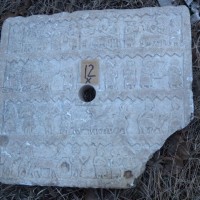
Prison Construction Leads to Discovery of 3,000-Year-Old Prehistoric Settlement in UK

The 3,000-year-old prehistoric settlement in Inverness, Scotland, UK, has been found as a result of the building of a prison. Photo: AOC Archaeology / BBC News
An exciting archaeological discovery has been made at the construction site of a new prison in Scotland, UK, where evidence of a prehistoric settlement from the Bronze and Iron Ages dating back 3,000 years has been unearthed.
The find during the construction of the HMP Highland in Inverness, Scotland, the UK, includes remnants of 16 roundhouses, indicative of habitation during the Iron and Bronze ages, shedding new light on the ancient history embedded within this modern development project, BBC News reports.
During the first phase of development at the prison site, these significant archaeological findings were made, revealing not only the structures themselves but also a wealth of artifacts that offer insights into the daily lives and technological advancements of the settlement’s ancient inhabitants.
Archaeologists involved in the excavation have reported that some of the artifacts, such as clay molds and materials made of a copper alloy, could be as much as 3,000 years old.
These items are thought to have been used in the crafting of swords, highlighting the sophisticated metallurgical skills of the time.
The structural remains of the roundhouses are particularly well-preserved, with holes for timber posts that would have supported substantial hut-like buildings.
Additionally, it has been noted by archaeologists that the interiors of some of these houses were fortified with palisade fencing, suggesting a well-organized community that took measures to protect and stabilize their dwellings.
The range of prehistoric artifacts discovered at the site is extensive.
Alongside the metallurgical finds, stone whetstones for sharpening tools and querns for grinding grain were uncovered, providing a glimpse into the daily activities of the settlement’s inhabitants.
These artifacts, along with pottery and worked flint tools that were also found, contribute to our understanding of the prehistoric lifestyle and technological practices of the period.
The excavation has been a collaborative effort involving AOC Archaeology Group and contractors from UBCivils and Balfour Beatty.
This partnership was orchestrated under the oversight of the Scottish Prison Service (SPS), which has played a crucial role in facilitating the archaeological work.
The site of the new prison is part of a larger archaeological area known for its historically significant discoveries, with notable finds previously reported at nearby locations such as Culduthel, Slackbuie, and West Link Road.
Mary Peteranna of AOC Archaeology Group emphasized the cooperative nature of this significant archaeological venture.
“The collaboration was made possible by the support of the Scottish Prison Service. They facilitated the process of safeguarding the archaeology on the site and have been fully supportive of the presentation of the results so that it is available to the public. This is a truly important part of the cultural heritage of Inverness,” she stated.
Lorraine Roughan, SPS project executive for HMP Highland, also commented on the discovery’s broader implications.
“This discovery encapsulates the importance of the site to the community of Inverness, both historically and in the present day,” Roughan said.
The new HMP Highland is set to replace the over 120-year-old Inverness Prison and will accommodate up to 200 prisoners.
However, the development of this modern facility has come with significant financial and time-related challenges.
The cost of constructing the new prison is expected to be four times higher than originally estimated, with completion also anticipated to be delayed by six years.
Despite these challenges, the archaeological discoveries have added a layer of historical significance to the site, intertwining the past and future of this location in Inverness.
***
DID YOU KNOW that there is now an entire ancient nation made up of archaeologists?
It exists against all odds in “The Mudbrick Swamp,” a fantasy book by Ivan Dikov – Volume 1 of the “Rodiniya’s Reason” fantasy series!
BUY ‘THE MUDBRICK SWAMP,’ Book 1, Volume 1, of the RODINIYA’S REASON fantasy series HERE!












